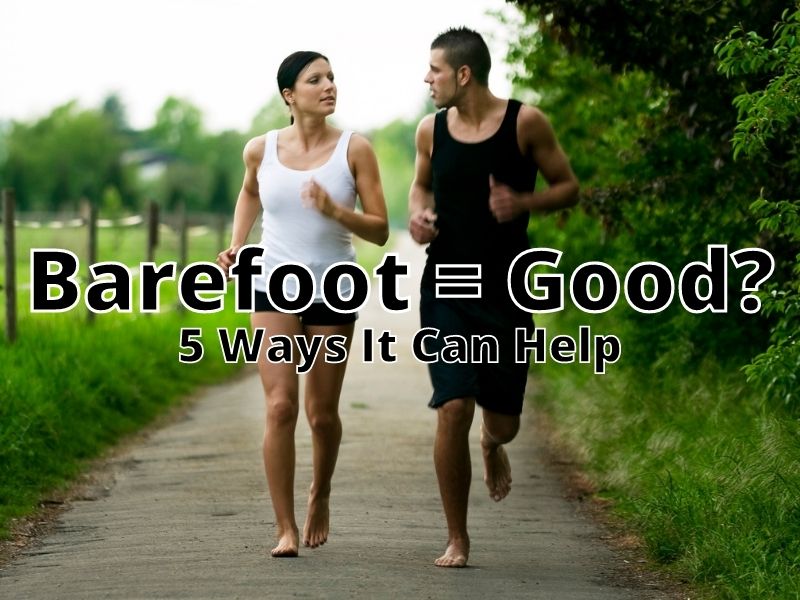Our feet are full of muscles that are designed to work to help us walk or run and stay injury-free. Once we start using thick-soled shoes our muscles don’t work the same way. Shoe inhibit the natural way we walk and run if we had no shoes.
Barefoot running can help your feet and legs develop the muscles and movements that naturally have benefits. As we develop these muscles and movements we can avoid a number of injuries. Arch development and natural biomechanical movements eventually benefit the foot and body.
I noticed a difference when I started walking in a zero drop shoe that had a wide toe box. My toes and feet felt more developed. I’ve never run or walked long without shoes, but I know that with time we can all develop the necessary muscle development to have strong healthy feet that result in fewer injuries.
A Transition to Barefoot Running Story
I think this video is worth watching because it describes the way that many people have transitioned from using thick-soled running shoes to barefoot running shoes. It shows that it is possible to reduce the number of injuries a runner may encounter.
Anyone who is willing to make a change to a barefoot running shoe should start to see some of the same results as Andrew in the video above, We all have different bone placement in our feet, so each person’s result will differ.
My opinion is that building up our natural foot strength is important, but if we are doing fine in our regular cushioned shoes then it’s probably fine to continue to run in shoes that work best for our feet.
What Did Nature Intend For Our Feet?
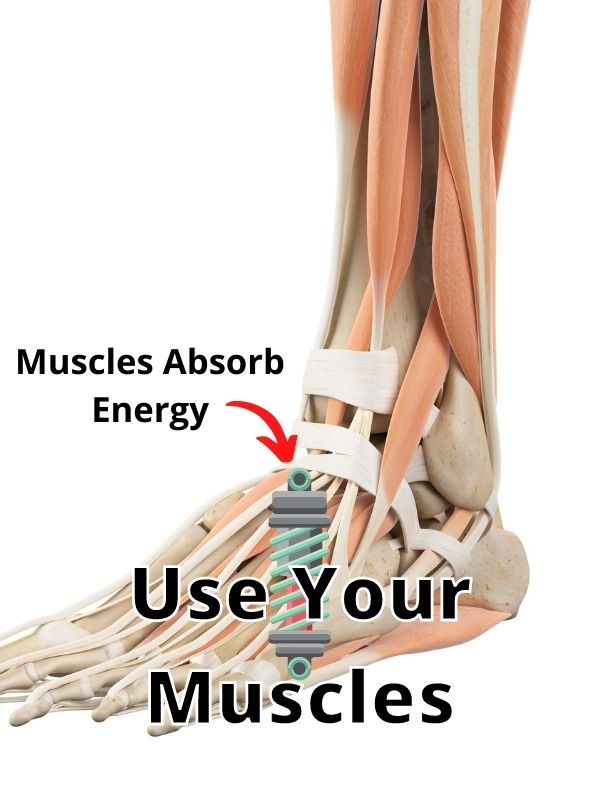
Nature intended for us to use our foot muscles.
As our feet get more exercise we develop a more unified foot structure. The muscles can all work together to absorb the energy from foot strikes as we run.
If you grew up in a foreign country you may have worn sandals every day or gone barefoot. People like this develop muscle structures in their feet over a lifetime that are different than those who have walked in shoes all their life.
People who use their muscles every day don’t have the same foot problems as those with shoes because their muscles and feet have adapted to take on the stresses of walking and running without the need for a cushion.
They started walking barefoot since they were young. Their control over and response from their foot muscles and toes make it easier for their feet to absorb impacts and exert forces with less chance of injury in many instances.
Nature intended for us to use our toes.
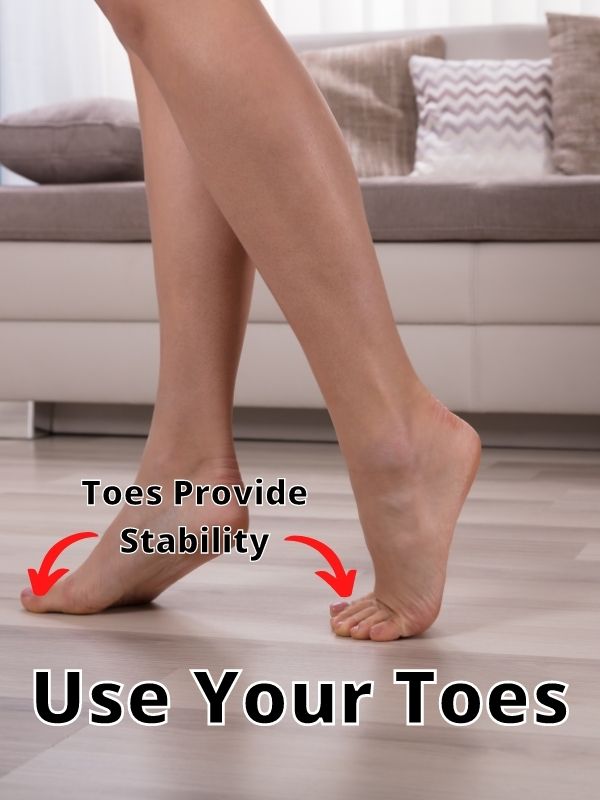
The toes can also play an important part in the relief of stress on the foot. They, like our fingers, can grow in strength and dexterity to help create a stable landing platform when feet impact the ground during running.
Then, as our foot roles forward onto our toes, their strength and dexterity can continue to provide stability and forward momentum.
If the entire foot is a unified structure then it can distribute forces better and help runners receive fewer injuries that are caused as a result of muscle weakness.
Nature intended for us to use our arch.
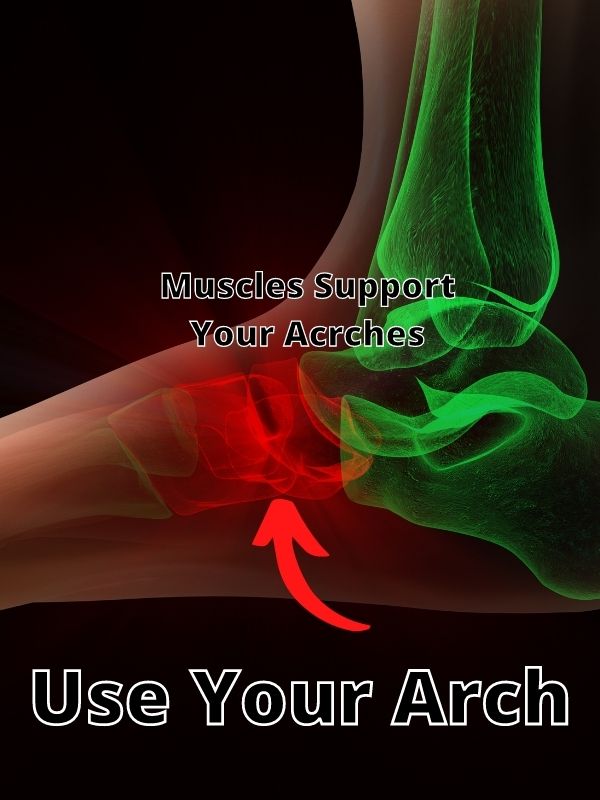
It can be beneficial at times to run with a forefoot strike in some shoes and there is an arch in the ball of our foot (transverse arch). Yet, the main arch we rely on to support our body is in our midfoot (longitudinal arch). (teachmeanatomy.info)
The arch is a bone structure supported by muscles. We each are born with flat feet that develop into an arch as we grow older. Our bone structure is usually genetic, so we may develop flat, normal, or high arches.
Regardless of our bone structure, muscle development is one of the key reasons our arch can operate effectively or not.
For example, those with flat feet may be able to go through physical therapy to help build muscles and possibly realign the bones if muscles are too tight. This development of muscle can support the foot and relieve some problems.
Once our arch is working at its best, we can better handle the stresses that come with running.
Nature intended for us to use feel the ground.
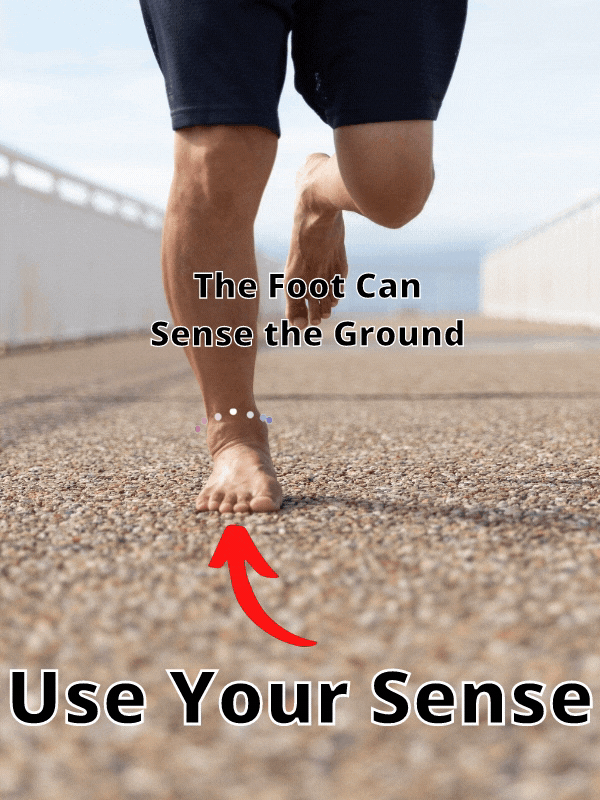
There are good arguments for both cushioned shoes and barefoot running shoes or going without shoes. In one study they found that the forces that were applied to runners in all types of shoes mostly averaged out. (outsideonline.com)
So why would it be helpful to run barefoot or with a minimalist sole? When you feel the ground, its bumps, hardness, and overall sensation, it gives your brain the information. This sensory perception is in many ways similar to how your hands feel objects.
After a while, you get used to holding something with your hand just the right way every time. It comes naturally. In a similar manner, our feet can get used to touching the ground and knowing how to move in the most effective way possible.
This will take time for those who are used to wearing shoes. If the transition is too fast injuries might occur. So, if I wear to transition to barefoot running I would need many months (probably at least 6 months for me) of walking, then some running, and finally running most of the time.
My muscles, arch, and sensory perception would need time to adjust until I was strong enough and my movements became natural.
Then, like many barefoot runners, my midfoot arch would absorb most of the impact during running. I would naturally adjust my foot movements to help further help prevent injuries.
How To Transition To Barefoot Running the Right Way?

You definitely don’t want to transition too fast or in other words push too much in the first month. You could possibly transition to barefoot running in a month if you are an active runner and already have fairly strong feet.
Other runners will need more time to build foot strength and get their arches supported by enough muscle.
The key to transitioning is to run the right way. According to xeroshoes.com, “It’s about form and function, not about seconds on the clock.” In other words, you want to focus on these key aspects of your running. Here are some ideas of how to do that from xeroshoes.com:
- Run normally. No over striding The foot for most barefoot runners will strike the ground on the midfoot and sometimes the forefoot.
- Don’t push off. If you were racing you might push off with the ball of your foot and roll onto your toes for that final push. Don’t do that. Just lift your foot after you strike the ground.
- Keep a steady pace. Get into a rhythm when running and keep your feet from striking the ground hard.
- Be comfortable. Let the legs and feet do the work while you exert little effort.
How Can Barefoot Running Heal Your Foot?
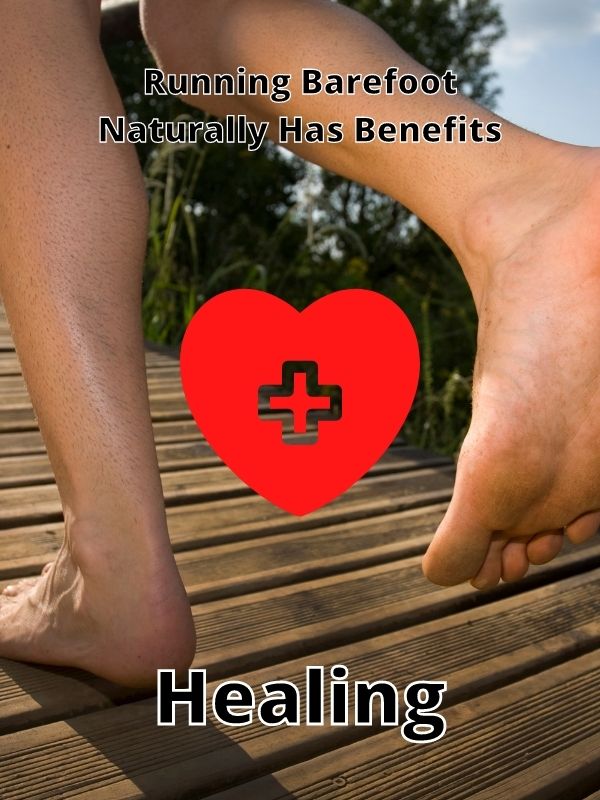
Barefoot runners can get injuries just like runners with shoes. The difference lies in how our feet start to change over time with barefoot running.
It comes down to support and form. If you have a well-supported foot and leg and run properly, your chances of getting injured are less. Your previous problems may go away because barefoot running naturally helps with support and natural biomechanical running.
1. Heal Shin Splints

Barefoot running can cause less stress on the shinbone and connective tissue. This might not be true in the beginning when you are transitioning to barefoot running. Although, over time the foot will develop muscles and patterns of movement that will aid in absorbing impacts effectively.
Then, the shin splints will heal instead of getting irritated repeatedly. This may not be true in every case though. Runners who have bad form, such as over-striding or running somewhat straight-legged, may not be able to get rid of their shin splits until they have adapted better to running barefoot or make a conscious effort to make a change.
Helpful Suggestions:
- Let your shin splints have time to heal and go running for shorter distances.
- Transition slowly to barefoot running, especially if you have high arches or flat feet.
2. Heal Knee Pain
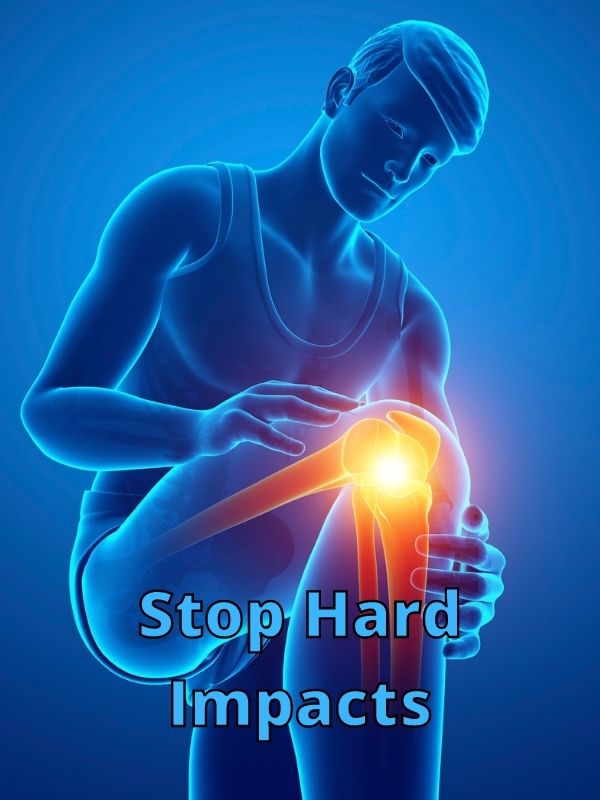
The feet have a natural spring, the arch. It can absorb much of the impact that occurs when running. The muscles and tendons work together to help absorb energy so the knee joint isn’t impacted. Although, an unsupported arch can’t reduce impacts well.
Runners who have joint pain are sometimes not getting enough cushioning when they run. Whether it’s their weight, lack of hydration, or age, runners can benefit from a stronger arch and overall unified foot structure.
Running barefoot can help develop the arch and may help relieve joint pain. Just remember to transition to barefoot running the right way.
Helpful Suggestions:
- Make sure to stretch your leg muscles if they are tight to avoid stronger impacts on the knee.
- Make sure you are hydrated.
- Make sure to strengthen the knee and surrounding muscles.
3. Heal Plantar Fasciitis
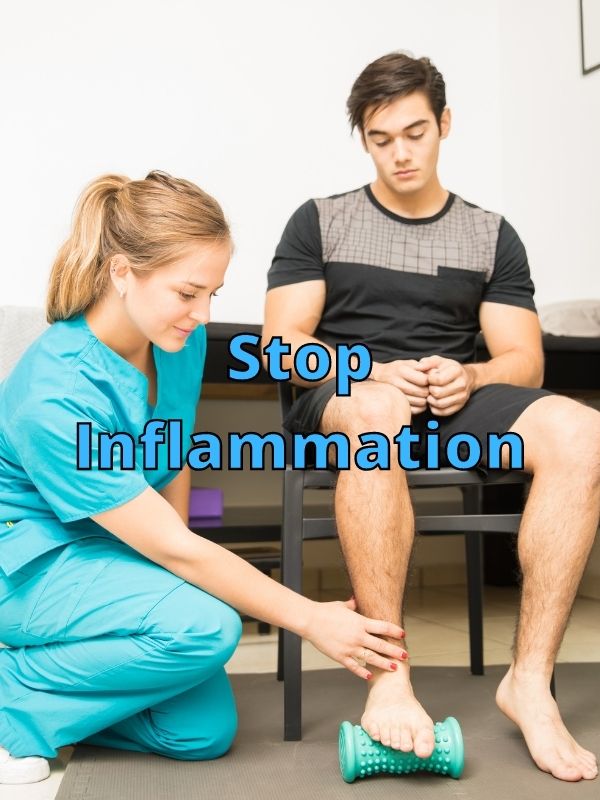
On the bottom of your foot, you have thick tissue called facia. It helps connect and support your foot and is stretchy. If you put too much pressure on it, it can become irritated or damaged.
People sometimes run too much or too fast and this can cause problems. “Muscle tightness or weaknesses in your calves can also put you at risk of plantar fasciitis.” (healthline.com)
If we start barefoot running this can help us to build up the muscle to support the facia in doing its job. If we are running barefoot correctly this can also prevent muscle from getting too tight.
Over time the facia should be able to heal and work in conjunction with strong muscles to support the foot.
Helpful Suggestions:
- Make sure to contact your doctor to diagnose if there are any other underlying issues in the foot.
- Make stretching a part of your daily routine until if you have tight muscles.
- In this article, I talk more about the symptoms and solutions to plantar fasciitis
4. Heal Pulled Muscles
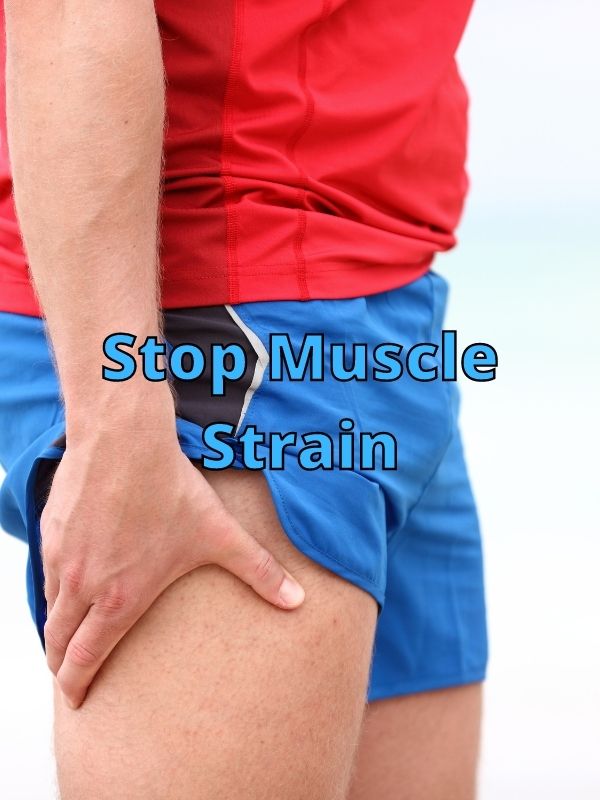
When you become an effective barefoot runner you start to run with less strain. This results in less chance of getting tight muscles. The opposite might be true when you first transition to barefoot running, so being aware of muscle tightness and strain is important.
If you get pulled muscles often, this likely means you have muscles that are frequently tight. Tight muscles can cause a lot of problems. Runners can get help by stretching and getting massages. Once they are relaxed you can prevent tight muscles by changing how you run, your shoes, or following a routine that helps you have relaxed muscles.
Muscles can heal better when they have the proper nutrients, hydration, and time to rest. If you want a permanent solution barefoot running can help. This type of running tends to create less muscle tightness after the transition period is done.
Helpful Suggestions:
- If you have chronic tight muscles you may need to see a physical therapist to determine if they can help. You may need to go through several rounds of stretching and possible realignment of your bones to get your foot healthy for running.
- If you have to exercise or use your pulled muscle after it’s pulled, use bandage wrap for compression, ice it, rest it, and elevate it.
5. Heal Achilles Tendonitis

When you are running a lot or putting a lot of strain on your calf muscles your Achilles tendon can get irritated. This can last a long time if you don’t let it heal or just keep taking medicine for the pain.
Uphill running may cause runners to land on the front of the foot and tends to cause tight calf muscles. If your training a lot and have tight muscles your Achilles tendon can get inflamed from the stress placed on it.
If you’re first transitioning to barefoot running Achilles tendonitis might be more of a problem since your muscles aren’t strong yet and there’s no cushion for your heel.
After your foot and leg are stronger just make sure the muscles in your foot and calf are not tight. Then, you can run barefoot and still climb hills without injury.
While you’re transitioning you will need to make sure your Achilles tendon is really ready for the drop in heel height if you haven’t been running barefoot for long (I would say at least 6 months).
One method to prepare your Achilles tendon for the height difference and uphill running that’s mentioned at fleetfeet.com is to do heel raises to gain muscle stretch and then lower your heel slowly to develop “eccentric strength!” That way your tendon can adjust to the stresses of uphill running better.
Helpful Suggestions:
- Ice your tendon when needed.
- Massage your leg and foot to release tight muscles.
My Opinion on Why Barefoot Running is Helpful
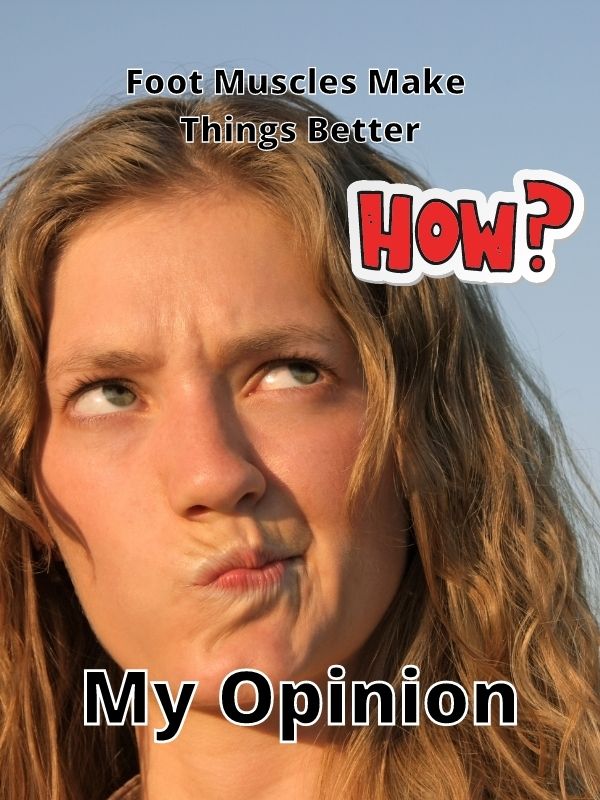
The science is still out, although there’s evidence both barefoot running and regular running can be helpful. Which is better? Barefoot running can be better, but it may not be for everyone.
I think that if you are willing to transition to barefoot running and do it the right way, you can be successful at avoiding a large number of problems that many runners encounter while running in shoes.
I say this for one main reason. You develop more muscle structure. This alone can make a big difference. Healing will come with more support and better functionality of the foot.
But… healing or avoiding problems is not going to happen overnight because your feet and legs need times to adjust and get stronger. You may need to work on foot and leg exercises to increase your overall capacity to run barefoot and stop injuries from occurring.
Long-distance runners are almost always going to have some type of problem when they run. They are putting so much strain on their legs and feet over a longer period of time.
Yet, I think one reason barefoot runners can fair well over both short and long distances is that they have increased their strength and their legs and feet have adapted (likely over a long time period) so that their legs and feet can withstand more stress.
One reason this might occur is the height of their foot in relation to the ground; it never changes even with new shoes. Their feet and legs adapt to this height and get stronger.
On the other hand, a cushioned running shoe’s height is always changing. The foam gets more and more compressed. Runners change shoes regularly and their feet may never have consistency.
Do Cushioned Shoes Help or Hurt?
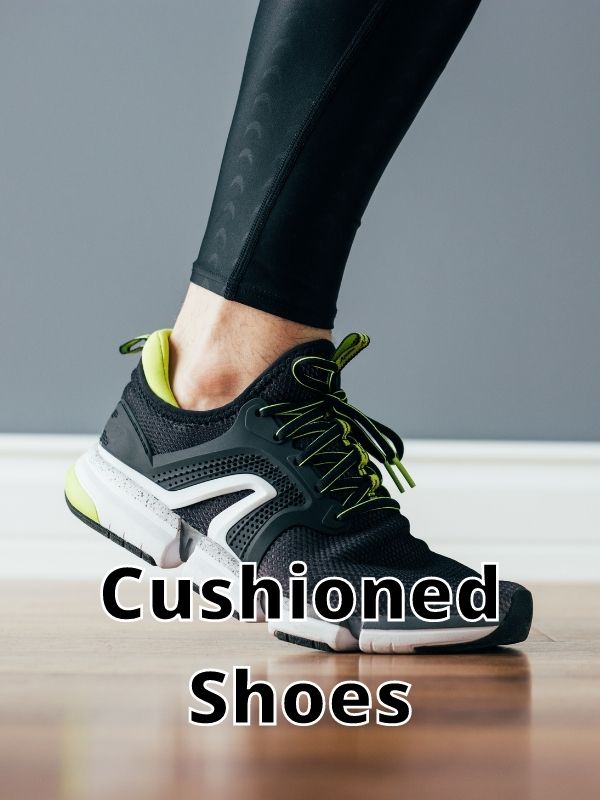
That’s a tricky question because a cushioned shoe can do both. Most runners want to have plenty of cushion unless they are trying to go faster and require a lighter shoe.
There are fewer aches and pains when you run in a nicely cushioned shoe. Yet, “By landing on the middle or front of the foot, barefoot runners have almost no impact collision, much less than most shod runners generate when they heel-strike.” (wikipedia.org)
When we wear shoes, how the shoe is built in some ways controls how we move our foot and the impact it receives. We might run very similar in almost any shoe we wear but how the shoe is built will eventually impact where we land on our foot and may start to change our running style the longer we use them.
And while cushioned shoes feel great and can prevent problems that occur with hard impacts, they also don’t allow the foot to get much stronger because the shoe is doing all the work.
So… would I get a cushioned shoe? Yes. I need cushioning because my feet aren’t strong. I think that strengthening feet and legs is the overall goal a runner should aim for, but having a cushioned shoe can help avoid some injuries and help the runner have a good experience running.
Conclusion
It’s fun to run when it’s fun to run. What I mean is when we run and struggle this can help us achieve our goals but we may end up getting a sprain or an injury if we aren’t careful.
When we run barefoot, it makes it possible to have a more enjoyable time. We can sense the ground and may better know our limits so we can avoid injury. In addition, your body adapts to help you avoid injuries. Running the way nature intended can bring more muscle, more control, and fewer injuries.
Yes, barefoot runners also get injuries, but I think it’s an important idea to consider if your a lifelong runner who’s ready for a change.
Thanks for visiting Helpshoe.com

